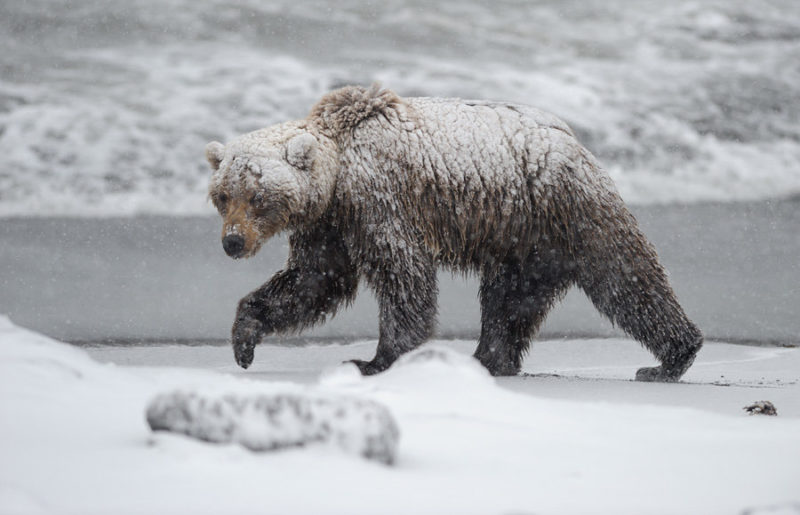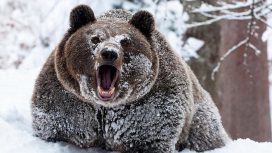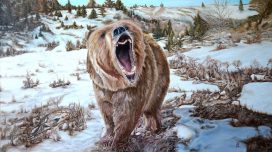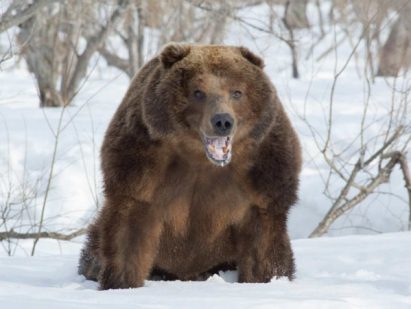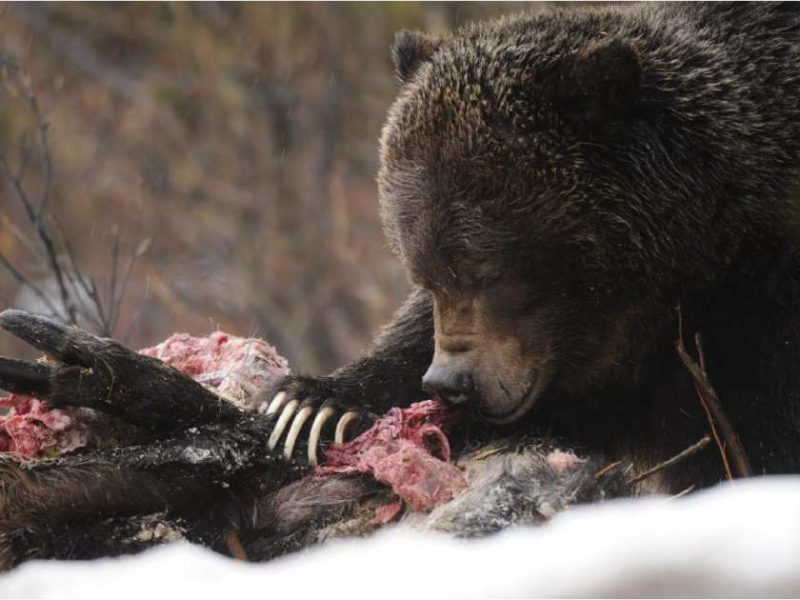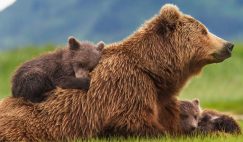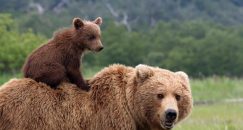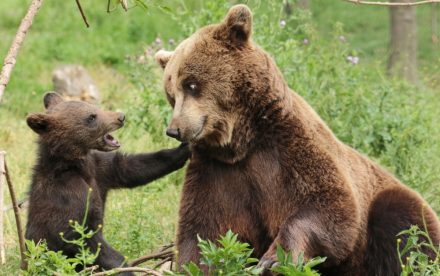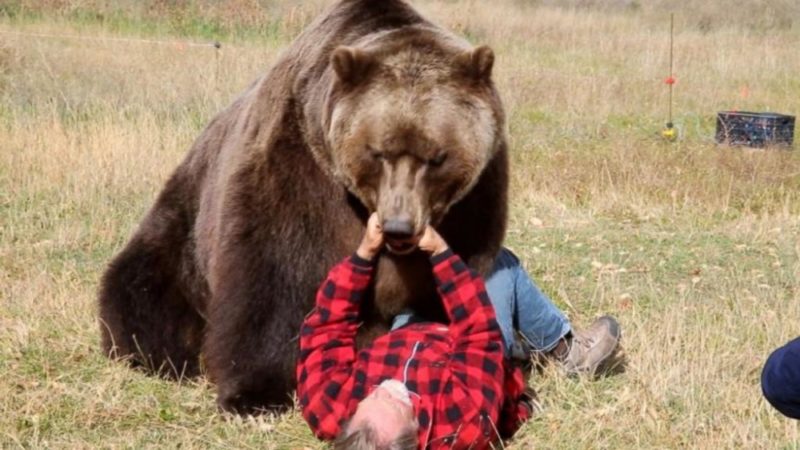More terrible than a bear-crank of an animal there is no beast. On the verge of life and death, crazy about cold and hunger, he doesn’t care. The animal is not afraid of anything and deadly for everyone it meets in its path.
Material Content:
Who is the connecting rod bear
A connecting rod is a brown bear, which in the summer for some reason was not able to accumulate a sufficient amount of subcutaneous fat. Now that winter has come, he does not sleep in the den. Staggering from exhaustion, prowls through the forest in search of food.
The movements of the animal are uncertain, it almost falls, swinging from side to side. It looks very emaciated, thin and battered. Often goes to human housing.
Bear behavior features
Poverty affects habits. All senses are in exacerbation mode: hears better, sees, recognizes odors, feels the vibration of the earth and air. He is only concerned about one thing - to find food. Even the instinct of self-preservation due to hunger is turned off.
The animal does what is not observed in the normal state. It attacks larger representatives of wildlife, often comes to settlements in search of food. If he finds the lair of his relative, he eats it and falls asleep.
This is very rare. More often, waking bears roam in search of food. They eat bark from trees, dig out moss, roots, algae. Sometimes, several kilograms of clay are found in the stomachs of dead connecting rods.
Such an animal is a danger to humans.
Lifestyle & Habitat
The brown bear is one of the largest land predators. Smart, strong, merciless.Its length is from 1.3 to 2.5 meters, weighs 200-450 kilograms. Females are 1.5 times smaller than males.
Thick, dense coat protects from insects in the summer and warms in the fall and spring. The skin has another important feature - moisture rolls down and the coat remains almost dry. It is painted from golden fawn to almost black.
Brown bears are territorial loners. Sometimes the possessions of an adult male reach 400 km2, females with cubs occupy an area almost 7 times smaller. The owner marks the borders, leaving an odorous secret or scratches tree trunks. They prefer a settled lifestyle, but sometimes they wander to places where there is more food and it is available as much as possible.
A characteristic feature is persistence. Animals are able to be stubborn in different situations.
Bears have a wonderful memory. They are smart and easy to learn. Experienced hunters say that bears, who used to see a trap and understand how it works, neutralize it by throwing stones and branches, only then they eat the bait.
Toes are curious by nature, but avoid encounters with humans. If it does occur, the behavior of the beast depends on the situation that led to such a meeting. Usually he does not attack people. He snorts menacingly, bounces and leaves, stopping and looking around several times. Their mood quickly changes, and this is the norm.
If a bear meets a person unexpectedly and completely by accident, then he has an bowel movement. In humans, this condition is called "bear disease."
With the onset of frost, individuals fall into hibernation. This period can last from 2.5 to 4 months. Before hibernation, animals try to actively gain weight by accumulating a sufficient amount of fat, which is spent during sleep to maintain body functions.
They sleep very sensitively. The animal does not fall asleep if it wakes up in the middle of winter. Angry and irritated wanders through the snowy forest in search of food.
Animal nutrition
Brown bears are omnivores. Their diet consists of 75% plant foods: roots, berries, bulbs, young shoots of shrubs and trees.
They can look into the garden, on a corn or oat field. Beetles, butterflies are eaten, sometimes they are eaten by ants. Do not give up fishing, hunting for frogs, lizards or rodents.
In Kamchatka, they go to the rivers during the period of salmon movement for spawning. They swim great, love to fish.
Another power source is carrion.
Brown bears prefer not to hunt, but sometimes attack roe deer, deer, and moose. Their activity manifests itself mainly at night or during twilight, although in some cases they wander through the forest more often during the day.
Breeding and offspring
Every 2–4 years, a bear is born. The gestation period lasts almost 200 days. Usually there are 2-3 cubs. They are born in a den in the middle of winter.
Deaf, blind and almost naked. After 14 days, they have a hearing, and only a month later their eyes open. A newborn teddy bear weighs 500 grams, and its length is 20-23 centimeters.
From the moment of birth to the awakening of the she-bear, babies are left to their own devices. If the mother is woken up, she will leave the wintering grounds and the cubs and will not return to this dwelling.
Bear cubs feed on milk for almost 120 days, then it is replaced by plant foods. The nutritional value of bear milk is 4 times that of cow milk. Often babies from the past offspring look after the babies. They care and try to protect the youngest.
At the age of 3 years, young cubs reach maturity and leave their mother. To adulthood, they grow for about 8 years. Outside, the bears live for about 30 years, in the zoo - almost 50.
Possible diseases
Sleep disturbance can be caused by injuries or ailments. An individual is not able to eat in sufficient volume, even a lot of food code.
After killing a connecting rod bear in winter, hunters often find round worms 7-10 cm long in the intestines. The parasite victim could not get enough and accumulate enough reserves to fall into hibernation.
This is the most common reason an animal becomes a connecting rod and roams through the forest. Toxins released by parasites poison the body. The beast grows thin, weakens and feels excessive hunger. The clubfoot usually hibernates in October. If their tracks are found in November or December, it means that there is a connecting rod in the forest.
Predator hibernation
Wintering is extremely important for clubfoot. Its duration is influenced by various factors. It takes 2 or more months. In warm areas where many berries and nuts grow, bears do not fall into winter sleep.
Preparations for the taiga wintering start in the summer. They find a suitable place, equip it, accumulate fat. A lair is usually set up in a pit among the roots of cedar pines or firs, under an inverted weatherproof tree.
Inside the den is fortified with branches. When the beast goes to bed, it closes until spring, before which it entangled the tracks so that no one could find it.
A claw-footed sleeping man, curled up in a ball, can be said to be “in an embryo position”, having pressed his hind legs to his stomach, covers his face with his front legs. Females hibernate with cubs that appeared last winter.
Every year, predators change their wintering, but if they could not choose a new place, they return to last year’s den. Usually, adults alone lie in manufactured housing. In the Kuril Islands and Sakhalin, they sometimes unite in one den.
The danger of a connecting rod bear to humans
The meeting of a man with a connecting rod poses a great threat to the first, because, having lost fear from hunger, the animal is capable of anything. In this case, the appearance of the beast is deceiving. He just seems completely weak. When the right moment comes, the beast mobilizes its last forces and goes ahead.
A connecting rod cannot hunt forest animals. His stamina and dexterity are almost at zero. At such a time, he is attracted to livestock that cannot escape. For this reason, a non-sleeping animal comes to the villages.
Lurking, patiently waiting for prey.
This can take several days or weeks. And when the food appears, nothing can hold the beast. He rushes into the thick of the herd, tearing livestock to pieces. It happened that a shepherd who did not have time to hide in time also becomes a victim.
Often brown bears knock on the windows of human habitation. They are able to break glass, climb into the house and kill everyone they find. Residents of areas where this can happen always have a loaded shotgun ready.
How to avoid meeting him
To avoid meeting a connecting rod bear, you can not:
- appear on the street in the evening;
- keep food waste in the yard because its smell attracts a hungry beast. https: //www.youtube.com/watch? v = Z74K-C8 — Ko
Northern peoples who live in yurts have centuries of experience in protecting against connecting rod bears. They enclose their dwellings with wooden poles and water them with water, which quickly becomes ice. A similar wall can save the yurt from the onslaught of a hungry bear.


